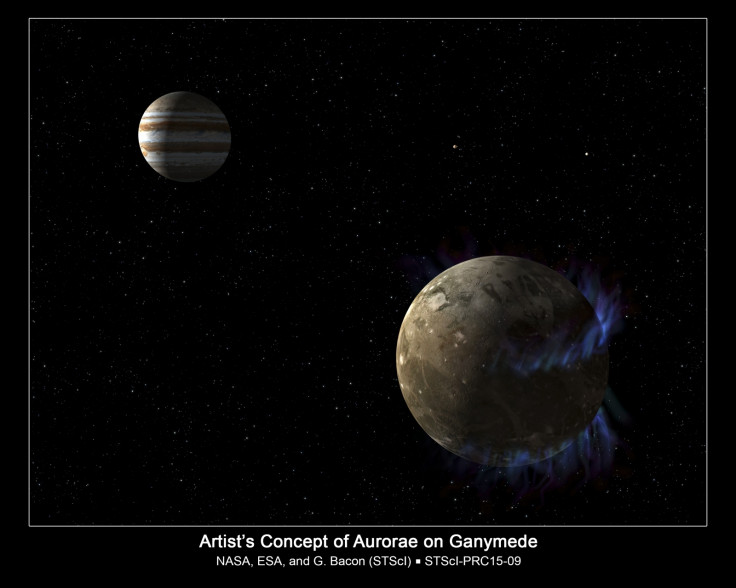Jupiter's largest moon Ganymede has massive underground saltwater oceans suggests Hubble study

A massive saltwater ocean under the icy crust of Jupiter's largest moon Ganymede has been strongly inferred by Nasa's Hubble Space Telescope study of the moon's "rocking" aurora.
Scientists estimate the ocean is 100 km thick - 10 times deeper than the Earth's oceans - and is buried under a 150-km crust of mostly ice.
Ganymede is the largest moon in our solar system and the only one with its own magnetic field albeit much small and suppressed by Jupiter's own massive magnetic field.
A team of scientists led by Joachim Saur of the University of Cologne in Germany came up with the idea of using Hubble to learn more about the inside of the moon.
The magnetic field of the moon causes aurorae, or ribbons of glowing, hot electrified gas, in the polar regions poles of the moon.
Being close to Jupiter, Ganymede is also embedded in Jupiter's magnetic field. When Jupiter's magnetic field changes, the aurorae on Ganymede also change, "rocking" back and forth.
If a saltwater ocean were present, Jupiter's magnetic field would create a secondary magnetic field in the ocean and this would counter Jupiter's field.
The resulting "magnetic friction" would suppress the rocking of Ganymede's aurorae.
The scientists calculated the reduction in rocking of the aurorae by salty oceans as 2 degrees, instead of the 6 degrees without such an ocean.
Observation of the rocking aurorae of Ganymede then clearly indicated a massive salty ocean underneath its crust.
"This discovery marks a significant milestone, highlighting what only Hubble can accomplish," said John Grunsfeld, associate administrator of Nasa's Science Mission Directorate at Nasa Headquarters, Washington.
"In its 25 years in orbit, Hubble has made many scientific discoveries in our own solar system. A deep ocean under the icy crust of Ganymede opens up further exciting possibilities for life beyond Earth."
Scientists ran more than 100 computer models to rule out other reasons for Ganymede's rocking aurora. They also repeated the seven-hour, ultraviolet Hubble observations and analyzed data for both belts of aurora.
"It is one step further toward finding that habitable, water-rich environment in our solar system," said astronomer Heidi Hammel with the Association of Universities for Research in Astronomy.
Ganymede joins Europa and Callisto (all moons of Jupiter) and Saturn's moon Encledus to be members of the solar system with subsurface water that can sustain life as we know it.
Galileo mission
Scientists first suspected an ocean in Ganymede in the 1970s, based on models of the large moon. Nasa's Galileo mission measured Ganymede's magnetic field in 2002 but not the cyclical rocking.
The new observations were done in ultraviolet light and could only be accomplished using HST orbiting above the Earth's atmosphere which blocks most ultraviolet light.
A study published in 2014 had suggested that there might be a stack of saltwater ocean layers separated by different phases of ice as far as 200km below the surface of Ganymede.
Just slightly smaller than Mars, Ganymede would have been classified a planet if orbiting the Sun. With a diameter of 5,268 km it is a third of the size of Earth and made of rocky material and water ice. It has a metallic iron and iron sulphide core which is surrounded by a rocky mantle and a thick icy crust.
Ganymede also has a very thin atmosphere with small amounts of oxygen but not enough to support any form of life.
Pioneer 10 and 11 in the 70s, followed by Voyager 1 and 2, Galileo and New Horizons (2007) craft have sent back snaps of the moon in flybys since decades.
© Copyright IBTimes 2025. All rights reserved.





















